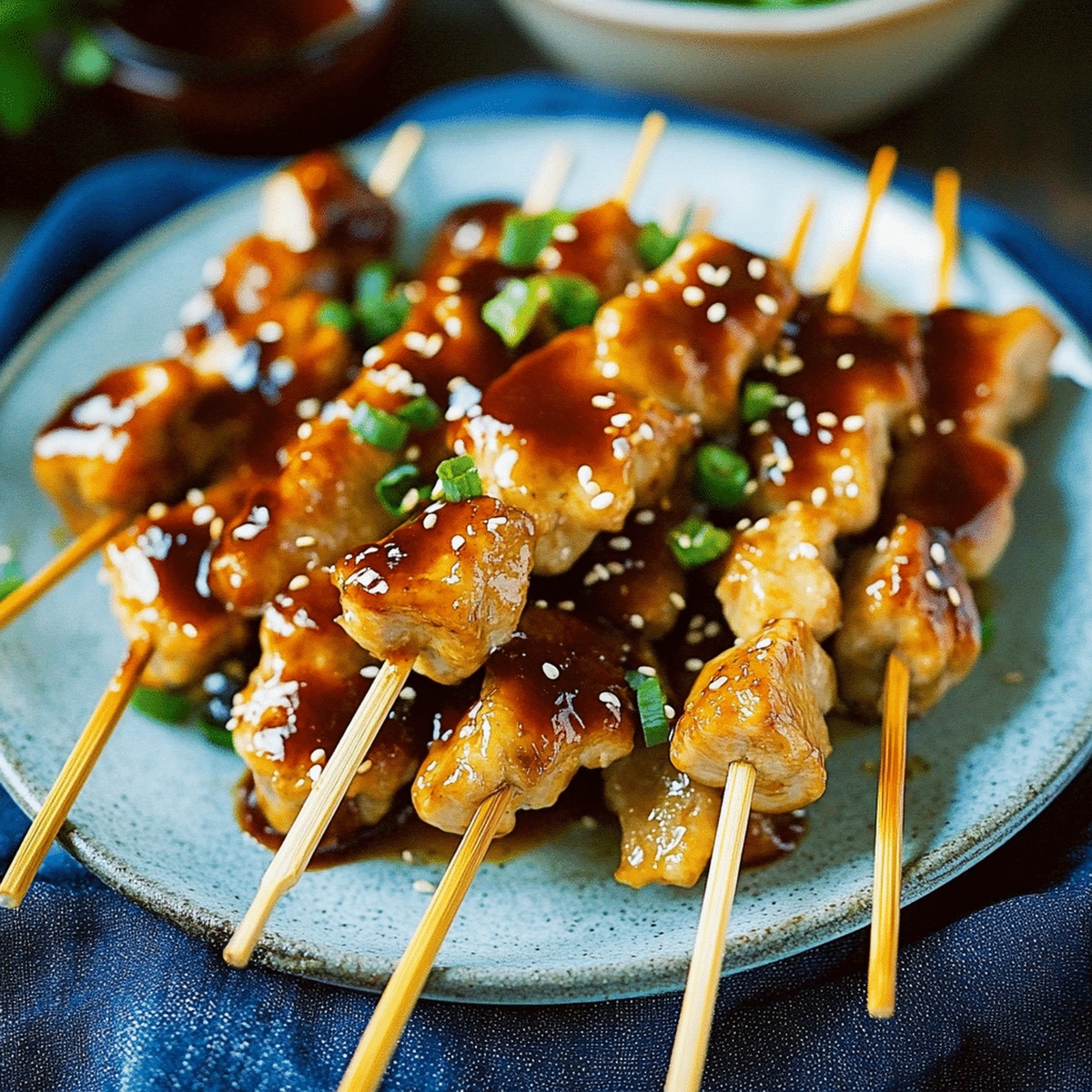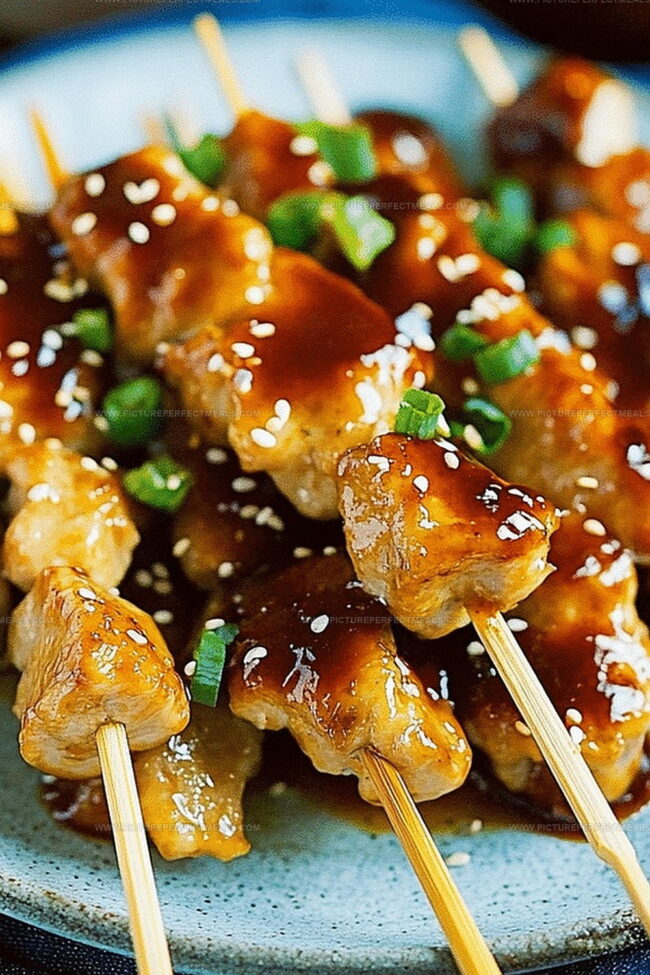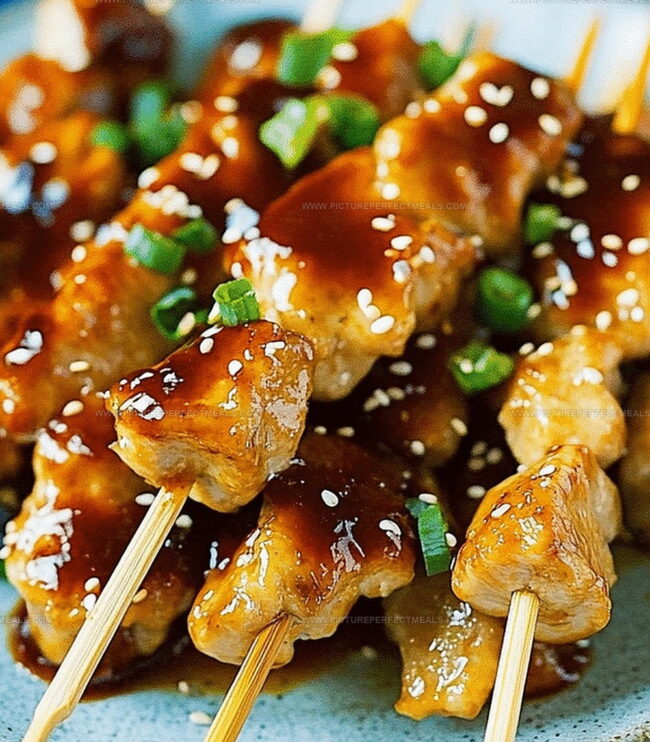Sizzling Homemade Yakitori Recipe: Smoky Sweet Japanese Skewers
Culinary wanderlust sparked my love for Japanese yakitori, a street-food delicacy that dances between smoky and savory.
Skewered chicken pieces gleam with a glossy, caramelized coating that promises depth of flavor.
Charcoal grills in Tokyo’s bustling alleys first introduced me to this simple yet magnificent dish.
Small bite-sized morsels of tender meat capture the essence of Japanese grilling traditions.
Each skewer tells a story of technique, precision, and generations of cooking wisdom.
Succulent chicken transforms under skilled hands, creating a symphony of textures and tastes.
We’ll uncover the secrets behind crafting authentic yakitori that will transport you straight to the vibrant streets of Japan.
Yakitori That Feels Like a Japanese Street Market
Ingredients for Savory, Glazed Chicken Skewers
Sauce Ingredients:Aromatics:Meat Base:How to Grill Yakitori Like a Pro
Step 1: Prepare the Flavor-Packed Marinade
Combine the following ingredients in a small saucepan:Whisk together to create a rich, aromatic base for your yakitori sauce.
Step 2: Simmer and Reduce the Sauce
Bring the mixture to a rolling boil over medium heat. Reduce heat to low and let it simmer gently. Stir occasionally to prevent burning. Continue cooking for 10-15 minutes until the sauce thickens and develops a glossy, deep flavor.
Step 3: Strain and Cool the Marinade
Remove the saucepan from heat. Strain the sauce through a fine-mesh sieve to remove garlic and ginger pieces. Let the marinade cool completely at room temperature.
Step 4: Prepare the Chicken
Cut chicken thighs or breast into uniform bite-sized pieces. Thread the chicken onto wooden skewers that have been soaked in water to prevent burning.
Step 5: Marinate the Chicken
Place the skewered chicken in a shallow dish. Pour the cooled marinade over the chicken, ensuring each piece is well-coated. Let marinate in the refrigerator for 30 minutes to 2 hours.
Step 6: Grill to Perfection
Preheat grill or grill pan to medium-high heat. Remove chicken from marinade and shake off excess sauce. Grill skewers for 3-4 minutes on each side, turning carefully to create a beautiful char and ensure even cooking.
Step 7: Baste and Finish
During the last minute of grilling, brush additional marinade onto the skewers for extra flavor and shine. Cook until chicken is fully cooked and has a deep golden-brown color.
Step 8: Serve and Enjoy
Transfer grilled yakitori to a serving plate. Garnish with chopped green onions or sesame seeds if desired. Serve hot with steamed rice or as an appetizer.
Tips for Char, Sauce, and Tender Chicken
Keep Yakitori Juicy After Cooking
What to Serve with These Flavorful Skewers
Sauce and Protein Options for New Yakitori Styles
Print
Yakitori Recipe
- Total Time: 35 minutes
- Yield: 4 1x
Description
Succulent Japanese yakitori skewers bring street-style grilling magic straight to home kitchens. Charcoal-kissed chicken pieces marinated in savory sauce promise a delightful culinary journey that whisks you through Tokyo’s bustling food scenes with each delectable bite.
Ingredients
Main Protein:
- 1 lb (454 grams) boneless, skinless chicken thighs, cut into bite-sized pieces
Seasonings and Liquids:
- ½ cup (120 milliliters) soy sauce
- ½ cup (120 milliliters) mirin
- ¼ cup (60 milliliters) sake
- 2 tablespoons sugar
Aromatics and Garnish:
- 4–6 green onions (scallions), cut into 2-inch pieces
- 2 garlic cloves, minced
- 1-inch piece of ginger, sliced
Cooking Accessories:
- Bamboo skewers (soaked in water for 30 minutes)
Instructions
- Craft a rich, savory glaze by blending soy sauce, mirin, sake, sugar, minced garlic, and grated ginger in a compact saucepan.
- Elevate the heat to generate a rolling boil, then immediately reduce to a gentle simmer, allowing the liquid to transform and concentrate for 10-15 minutes.
- Periodically stir the mixture, watching as it gradually thickens and develops a glossy, deep amber consistency.
- Carefully strain the glaze through a fine-mesh sieve, extracting the aromatic garlic and ginger solids and leaving behind a silky, refined sauce.
- Allow the glaze to cool to room temperature, during which it will continue to slightly condense and intensify its flavor profile.
- The resulting sauce will serve as a luxurious coating for grilled proteins, offering a harmonious blend of sweet, salty, and umami notes characteristic of traditional Japanese cuisine.
Notes
- Customize the sauce’s sweetness by adjusting sugar levels, ensuring a perfect balance between savory and sweet flavors.
- Use high-quality sake and mirin for an authentic Japanese taste that elevates the entire dish’s complexity.
- Marinate chicken for 30 minutes before grilling to enhance absorption of rich, umami-packed sauce flavors.
- Consider using alternative proteins like tofu or vegetables for vegetarian options, maintaining the signature glazing technique.
- Prep Time: 15 minutes
- Cook Time: 20 minutes
- Category: Dinner, Appetizer, Snacks
- Method: Simmering
- Cuisine: Japanese
Nutrition
- Serving Size: 4
- Calories: 280
- Sugar: 4 g
- Sodium: 1000 mg
- Fat: 10 g
- Saturated Fat: 2 g
- Unsaturated Fat: 8 g
- Trans Fat: 0 g
- Carbohydrates: 30 g
- Fiber: 1 g
- Protein: 20 g
- Cholesterol: 90 mg




Daves Miller
Contributing Chef & Culinary Educator
Expertise
Education
Sullivan University, Louisville, Kentucky
White Mountains Community College, Berlin, New Hampshire
Daves is the friendly face guiding you through flavorful, fuss-free recipes at Picture Perfect Meals.
He studied culinary arts at Sullivan University and embraced Baking and Pastry Arts at White Mountains Community College. Daves specializes in comforting meals with vibrant flavors, highlighting fresh, seasonal ingredients.